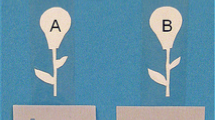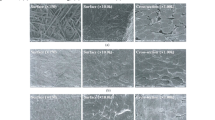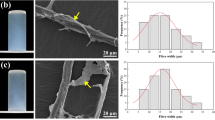Abstract
Though research into nanofibrillated cellulose (NFC) has recently increased, few studies have considered co-utilising NFC and nanographite (NG) in composite films, and, it has, however been a challenge to use high-yield pulp fibres (mechanical pulps) to produce this nanofibrillar material. It is worth noting that there is a significant difference between chemical pulp fibres and high-yield pulp fibres, as the former is composed mainly of cellulose and has a yield of approximately 50 % while the latter is consist of cellulose, hemicellulose and lignin, and has a yield of approximately 90 %. NFC was produced by combining TEMPO (2,2,6,6-tetramethypiperidine-1-oxyl)-mediated oxidation with the mechanical shearing of chemi-thermomechanical pulp (CTMP) and sulphite pulp (SP); the NG was produced by mechanically exfoliating graphite. The different NaClO dosages in the TEMPO system differently oxidised the fibres, altering their fibrillation efficiency. NFC–NG films were produced by casting in a Petri dish. We examine the effect of NG on the sheet-resistance and mechanical properties of NFC films. Addition of 10 wt% NG to 90 wt% NFC of sample CC2 (5 mmol NaClO CTMP-NFC homogenised for 60 min) improved the sheet resistance, i.e. from that of an insulating pure NFC film to 180 Ω/sq. Further addition of 20 (CC3) and 25 wt% (CC4) of NG to 80 and 75 wt% respectively, lowered the sheet resistance to 17 and 9 Ω/sq, respectively. For the mechanical properties, we found that adding 10 wt% NG to 90 wt% NFC of sample HH2 (5 mmol NaClO SP-NFC homogenised for 60 min) improved the tensile index by 28 %, tensile stiffness index by 20 %, and peak load by 28 %. The film’s surface morphology was visualised using scanning electron microscopy, revealing the fibrillated structure of NFC and NG. This methodology yields NFC–NG films that are mechanically stable, bendable, and flexible.








Similar content being viewed by others
References
Abdul Khalil HPS, Bhat AH, Ireana Yusra AF (2012) Green composites from sustainable cellulose nanofibrils: a review. Carbohydr Polym 87(2):963–979
Andres B, Forsberg S, Dahlström C, Blomquist N, Olin H (2014) Enhanced electrical and mechanical properties of nanographite electrodes for supercapacitors by addition of nanofibrillated cellulose. Phys Status Solidi B 251(12):2581–2586
Blomquist N, Engström A-C, Hummelgård M, Andres B, Forsberg S, Olin H (2016) Large-scale production of nanographite by tube-shear exfoliation in water. PLoS ONE 11(4):e0154686. doi:10.1371/journal.pone.0154686
Carrasco PM, Montes S, Garcia I, Borghei M, Jiang H, Odriozola I, Cabanero G, Ruiz V (2014) High-concentration aqueous dispersions of graphene produced by exfoliation of graphite using cellulose nanocrystals. Carbon 70:157–163
De Nooy AEJ, Besemer AC, Van Bekkum H (1995) Highly selective nitroxyl radical-mediated oxidation of primary alcohol groups in water-soluble glucans. Carbohydr Res 269(1):89–98
Eda G, Chhowalla M (2009) Graphene-based composite thin films for electronics. Nano Lett 9(2):814–818
Fall AB, Lindström SB, Sundman O, Ödberg L, Wågberg L (2011) Colloidal stability of aqueous nanofibrillated cellulose dispersions. Langmuir 27(18):11332–11338
Herrick FW, Casebier RL, Hamilton JK, Sandberg KR (1983) Microfibrillated cellulose: morphology and accessibility. J Appl Polym Sci Symp 37:797–813
Hubbe MA, Rojas OJ, Lucia LA, Sain M (2008) Cellulosic nanocomposites: a review. BioResources 3(3):929–980
Kim H, Miura Y, Macosko CW (2010) Graphene/polyurethane nanocomposites for improved gas barrier and electrical conductivity. Chem Mater 22:3441–3450
Kiziltas EE, Kiziltas A, Rhodes K, Emanetoglue NW, Blumentritt M, Gardner DJ (2016) Electrically conductive nano graphite-filled bacterial cellulose composites. Carbohydr Polym 136:1144–1151
Klemm D, Kramer F, Moritz S, Lindström T, Ankerfors M, Gray D, Dorris A (2011) Nanocelluloses: a new family of nature-based materials. Angew Chem Int Edit 50(24):5438–5466
Li Y, Zhu H, Zhu S, Wan J, Liu Z, Vaaland O, Lacey S, Fang Z, Dai H, Li T, Hu L (2015) Hybridizing wood cellulose and graphene oxide toward high-performance fibers. NPG Asia Mater 7:1–10
Luong ND, Pahimanolis N, Hippi U, Korhonen JT, Ruokolainen J, Johansson L-S, Nam J-D, Seppälä J (2011) Graphene/cellulose nanocomposite paper with high electrical and mechanical performances. J Mater Chem 21:13991–13998
Ma P, Zhai H (2013) Selective TEMPO-mediated oxidation of thermomechanical pulp. BioResources 8(3):4396–4405
Malho J-M, Laaksonen P, Walther A, Ikkala O, Linder MB (2012) Facile method for stiff, tough, and strong nanocomposites by direct exfoliation of multilayered graphene into native nanocellulose matrix. Biomacromolecules 13:1093–1099
Novoselov KS, Fal’ko VI, Colombo L, Gellert PR, Schwab MG, Kim K (2012) A roadmap for graphene. Nature 490:192–200
Okita Y, Saito T, Isogai A (2009) TEMPO-mediated oxidation of softwood thermomechanical pulp. Holzforschung 63:529–535
Saito T, Nishiyama Y, Putaux JL, Vignon M, Isogai A (2006) Homogeneous suspensions of individualized microfibrils from TEMPO-catalyzed oxidation of native cellulose. Biomacromolecules 7:1687–1691
Siró I, Plackett D (2010) Microfibrillated cellulose and new nanocomposite materials: a review. Cellulose 17(3):459–494
Stankovich S, Dikin DA, Dommett GHB, Kohlhaas KM, Zimney EJ, Stach EA, Piner RD, Nguyen ST, Ruoff RS (2006) Graphene-based composite materials. Nature 442:282–286
Turbak AF, Snyder FW, Sandberg KR (1983) Microfibrillated cellulose, a new cellulose product: properties, uses, and commercial potential. J Appl Polym Sci Appl Polym Symp 37:815–827
Wang F, Drzal LT, Qin Y, Huang Z (2015) Multifunctional graphene nanoplatelets/cellulose nanocrystals composite paper. Compos B 79:521–529
Yan C, Wang J, Kang W, Cui M, Wang X, Foo CY, Chee KJ, Lee PS (2014) Highly stretchable piezoresistive graphene–nanocellulose nanopaper for strain sensors. Adv Mater 26:2022–2027
Acknowledgments
This work was financially supported by the KK Foundation in collaboration with MoRe Research and Mid Sweden University as part of the programme Forest as a Resource Industrial Research College (FORIC) at Mid Sweden University.
Author information
Authors and Affiliations
Corresponding author
Rights and permissions
About this article
Cite this article
Osong, S.H., Dahlström, C., Forsberg, S. et al. Nanofibrillated cellulose/nanographite composite films. Cellulose 23, 2487–2500 (2016). https://doi.org/10.1007/s10570-016-0990-2
Received:
Accepted:
Published:
Issue Date:
DOI: https://doi.org/10.1007/s10570-016-0990-2




